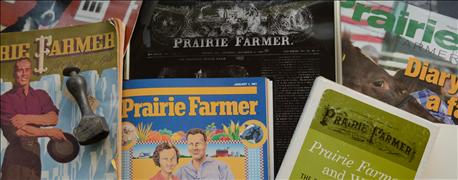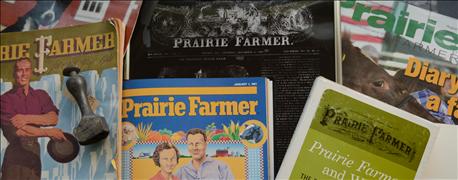
As the 21st century dawned on Illinois agriculture, it brought with it a renewed sense of industry, conversation and turmoil. These are the years that saw terrorism on our shores, ethanol in our cars, $7 corn in our bins and autosteer in our tractors. Take a look at our modern history here.
2000-2016: Terrorism and technology

175 YEARS: Celebrating Prairie Farmer, 1841-2016
The new century dawned bright on the American farm. While corn and soybean prices were low enough to trigger loan deficiency payments and conversations about county averages, crop years were plentiful. At the behest of their farm organizations, farmers traveled to Washington, D.C., to explain the need for disaster payments — conversations that would ultimately lead to farm payment reform and federally backed crop insurance.
2001 brought more of the same for crops, plus the singular defining event of the decade for farmers and non-farmers alike: Sept. 11. When terrorists crashed four planes on a crisp, clear September morning, farmers stopped in their tracks to take it in. Across the Midwest, often dubbed “flyover country,” rural families couldn’t help but notice a sky devoid of jet trails that day, as air traffic ground to a halt. The sobering day brought a call to fight terrorism overseas, and many young farmers answered the call to military service.

WAR: In a show of patriotism, Prairie Farmer carried the flag on its corner for several years following 9/11.
Technology continued to move forward during the 2000s. Autosteer took off “like a rocket,” notes Prairie Farmer Hi-Tech columnist Tom J. Bechman. “Autosteer kick-started precision farming again,” he adds. “It hasn’t stopped and won’t stop.” Within a few short years, technologies like autosteer, autoclutches and row shutoffs would make their way into sprayers, planters and even fertilizer applicators. Farmers also began using drones, looking at ways to harness aerial crop data.
The mid-2000s saw a change in a venerable Illinois institution: the Farm Progress Show. It took up a semipermanent show site in Decatur, and would rotate between Decatur and Boone, Iowa, until present day. While the semipermanent sites marked the end of the excitement that came with visiting a different farm every year, they helped show organizers put on a more professional show – without so much impact from the whims of Mother Nature.
Farmers worked to build ethanol plants, and to build legislative and regulatory support for ethanol, through this period as well. Global weather problems created a spike in commodity prices by 2007. While farmers and experts debated whether new prices marked a new era in commodity markets, farmers soon learned the answer: No. By 2014, corn prices were headed back to sub-$4, and experts began pondering whether the industry would see a repeat of the 1980s farm crisis.

CYCLES: The mid-2010s saw lower prices again, and farmers and experts debated whether markets would bring with them the 1980s farm crisis all over again.
With higher corn and soybean prices came higher land prices, as both landowners and farmers demanded more for their ground. Prices for Class A farmland in Illinois soared past the $15,000-per-acre mark. Cash rent followed suit, and $300-per-acre rents became the norm. By 2015, those prices began to level off, as did cash rents. As longtime Prairie Farmer economics editor John Otte was fond of saying, “Prices — like pork chops — are sticky downwards.”
In the field, farmers learned to plant refuges to ward off insect resistances to biotechnology traits. They also watched weeds become resistant to herbicides as glyphosate became the crop protection chemical of choice. By 2010, Southern U.S. farmers were noting glyphosate-resistant waterhemp and marestail. Palmer amaranth became a significant weed problem shortly after, and farmers began using cover crops to reduce runoff and harness nutrients.

STEWARDS: As they incorporated biotech traits on their farms, Illinois farmers learned to be biotechnology stewards — even signing on the dotted line.
Off the farm, consumers began to pay more attention to food production. After years of funding Ag in the Classroom projects and imploring the industry to “educate consumers about agriculture,” those consumers were finally paying attention — though not always to farmers. Movies like “King Corn” and “Food, Inc.” dominated conversations, and farmers scrambled to become a part. Illinois farm groups funded and formed the Illinois Farm Families coalition, aimed at engaging Chicago consumers about food production and bringing them to farms. Nationwide, the U.S. Farmers and Ranchers Alliance was formed, and farmers across the country sought to engage consumers through blogs and social media. Many farm women, in particular, found their voice in speaking out for agriculture through blogs and conferences.
Weather continued to swing wildly through much of this period, and across the state of Illinois. Compared to 1988, the Drought of 2012 created drier and hotter conditions during the peak growing season, resulting in an average corn yield of 122 bushels per acre — though many farmers reported significantly lower yields than the average.
Alternative energy came to the farm during this period as well, as wind turbines began to dot the rural landscape, and both wind and solar energy farms approached farmers to sign leases.
Overall, these years saw a rise in globalization and increased trade and exports. Rising pork exports carried pork prices higher, and the hog industry continued a move toward contract production. With lower grain prices in the 2013-16 time period, farmers became interested once again in diversifying and in livestock production. Farmers again branched out from No. 2 yellow corn production to diversified businesses, crops, contract production and more.

LIVESTOCK: Lower prices and diversification brought hogs and cattle back to farms where they’d been missing for a generation. And with them: nutrient-rich manure to apply on fields.
The mid-2015 time period saw farmers — and their farm organizations — spending more time fighting government regulations, including state and federal EPA, child labor regulations, and U.S. EPA’s Waters of the U.S. rule. Meanwhile, a coalition of Illinois farmers and nutrient experts began looking at ways to use nitrogen more responsibly – hopefully avoiding further regulations.
For more on this series, check out our other “From Prairie Farmer’s pages” stories:
About the Author(s)
You May Also Like






